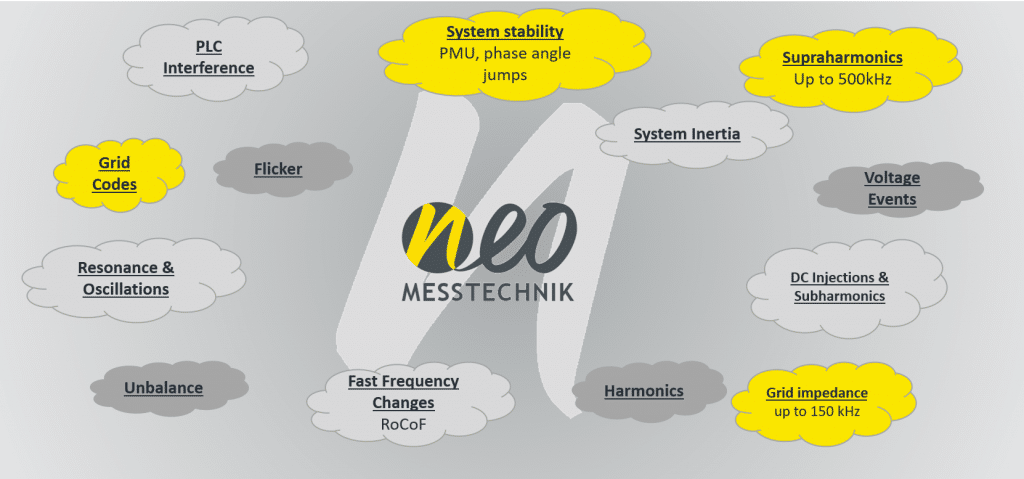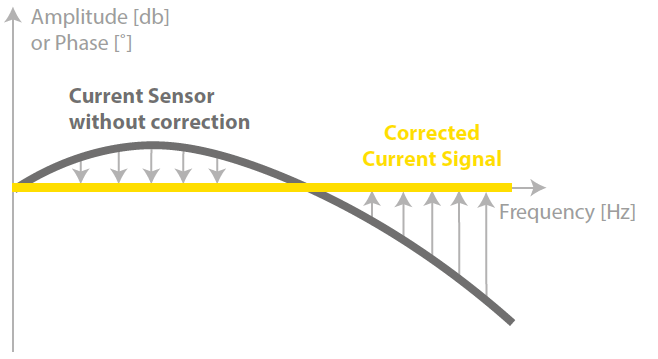
Power Quality Explained – Chapter 1 – Foundational Knowledge
- Posted by Neo Messtechnik
- On 10. February 2021
- 0 Comments
The force of electric power is hard to imagine unless you explain it by means of other forms of energy. It is all the more challenging to understand the importance of Power Quality as all effort put into it only improves the familiar and excellent status quo. Which itself is a testimony of Power Quality provided by all parties involved.
Table of Contents
1 – Introduction
Back to the Basics
While the energy and electric power supply is rightfully considered a complex and interdisciplinary topic, it certainly affects everyone. In today’s society, a safe and reliable power supply only allows us to casually charge our phones or make life easier by various household devices. Electric power is much more – you could say it is essential for the functioning of our day-to-day life. It is hard to fully appreciate, because we are almost never left without it. In the rare case it happened or may happen again, our view changes dramatically.
Power Quality Explained – Welcome to our Multipart-Series
Throw away old Power Quality books, stop looking for new ones. In 2021, the NEO Power Quality Blog explains what you need to know about Power Quality Management. Over the next chapters we give you an introduction to the world of electric power and Power Quality. Starting with the grid operator’s perspective will help us talking about real-life deviations from the ideal power supply. Thereby we will automatically underline the importance of Power Quality and how it affects both industrial and private consumer.
You will be surprised how diverse the effects of poor Power Quality can be. Even more intrigued about how both challenging and easy it can be to troubleshoot.
There are definitely many topics and phenomena to manage in the PQ field. We decided to create a multipart-series diving a little bit deeper in each chapter.
Power Quality – A Reintroduction served as introductory chapter, focusing on the challenges and emerging PQ phenomena we see in today’s power grid. Among other topics like Wind and PV testing or Supraharmonics effects on Power Line Communication (PLC) of Smart Meters, we will certainly cover a wide range of topics in upcoming publications. As of today, we start on square zero.
One last thing before you start reading
You maybe ask yourself why we started this Power Quality Blog in the first place? Well, it is a great platform to share our experience and knowledge. Experience that we have gained in the last 20 years in the fields of hardware and software development and the PQ Analysis and Monitoring Market.
Power Quality also means working together for a safe and reliable power supply. Similar to that, this blog aims to start conversations and highlight the importance of co-operation by every party involved. Let’s hear from you – we’re ready to answer your comments, questions or suggestions for future articles!
2 – The grid operator’s perspective
Coming back to the introductory chapters of this article, we highlighted the importance of electric power in our day-to-day life. Talking about the increasing challenges, grid operators ensure that Power Quality phenomena stay within given limits according to standards and Grid Codes.
Power Quality defines the framework of the electric power delivery consumers need – and expect – to run their equipment properly. While a power failure may be the obvious worst case scenario for every end user or factories, even small disturbances like voltage dips, transient currents or unbalance endanger the continuity of power supply as well. Very often end users start to notice problems because of their sensitive equipment. On the other side, PQ also holds end users accountable to limit their influence on the power system. For example by means of limiting harmonic currents.
By monitoring and analysing voltage and current over a certain period of time, both grid operators and consumers gather information about the current state of the grid. Furthermore they are able to manage problems, as certain PQ phenomena can often be traced back to a certain cause.
3 – Foundational Knowledge Power Quality
Classic PQ Phenomena
Whenever electric wave signals deviate from ideal sinus waveforms, Power Quality phenomena arise. As a result, Power Quality Analysers and Monitors are needed and used to ensure grid stability. From our experience, PQ Management nowadays goes way beyond EN50160 and other reports. We will cover the following phenomena in Chapter 2 very soon:
- Power and Energy (Apparent, Active and Reactive Power, Power Factor, Distortion)
- Voltage Variations (Dips, Swells, Spikes, Rapid Voltage Changes)
- Harmonics (Interharmonics, Total Harmonic Distortion (THD))
- Flicker (Short- and Long-time Flicker, Pinst, Pst, Plt, Flicker current, phase angles)
- Unbalance (Symmetrical components: Zero, Positive and Negative Sequence)
Emerging PQ Phenomena
As we have already discussed in our previous article, a various number of PQ phenomena shift into the focus of our customers and the Analysis and Monitoring market in general. For these phenomena we will go into greater detail in future blog posts. Furthermore, you can soon access specific AppNotes in your personal NEO Download Area.

4 – Fundamentals on Computer-based PQ Analyzer
Skip the past. Look at present-day technology.
In this chapter we spare you a lot of hassle and headache by not talking about (outdated) measurement equipment and approaches where you will end up with several different instruments or data merging catastrophes that will consume too many hours of your time.
So let’s cut corners straight to computer-based PQ Analyzers. Why? Because we believe that you shouldn’t spend a single hour on devices designed for the power grid of the past. Measurement equipment must not limit engineers any longer. We don’t want to rely on separate instruments with different time stamps and file formats, when you can have everything on a single instrument or platform. Taking our devices as examples, they combine the functionality of multiple instruments. They also measure and analyse according to international standards IEC 61000-4-7, IEC 61000-4-15, EN 50160, and the Analyzers fully comply with IEC 61000-4-30 standard, class A.
Foundations of AC-Conversion
The performance of hardware, bandwidth, accuracy and resolution has increased dramatically over the past 10 years to the point that the performance of computer-based digitizers is comparable to traditional instruments. Today, virtually all common measurements and complex applications, such as FFTs and signal processing routines, can be done in less time and at a lower cost due to the declining prices of measurement components. Moreover, these components are tightly integrated with the software. It is easy to reconfigure the computer-based system to follow your demands.
Which factors are to consider for AD-conversion? Bandwidth or measurement range probably first come to mind. For us, it’s something different. Have you ever thought about the necessity of correcting frequency-dependent behaviour of voltage and current sensors or integrated electronics? Ok, to be fair, we maybe just skipped a step or two..
Measuring voltage signals with Data Aquisition (DAQ) devices requires knowledge about the following:
- range of input signals (µV up to kV)
- Bandwidth (up to MHz)
- using the right amplifiers,
- selecting the according measurement range
- being aware of phenomena like ground loops, disturbances and noise signals.
Choosing the right amplifier
In terms of isolation voltage, this is very important for a safe and reliable measurement setup. In order to avoid electrical accidents, we strongly emphasize the importance of safe instrument design. Unfortunately, we quite often see instruments that don’t even fulfil the required safety categories for the respective measurements (CAT III 1000V / CAT IV 600V). As a matter of fact, the High-Voltage inputs of our PQA 8000 instrument (CAT IV 600V) are isolated up to 6kVp – while maintaining high precision (0.05%) and sampling rate (up to 1MS/s).

Does your measurement equipment keep up with the rapid increase of switching frequencies?
Measurement range & Resolution
Selecting the right measurement range for input channels is vital for the further conditioning and analysis of signals. Configurable amplifiers allow users to select the right measurement range via the software. At this point we would like to take a closer look at how the selected range is vital for the accuracy and reliable results.
- Choosing a range that is smaller than the expected input signal will result in a channel overload.
- Choosing a range that is too big, the inaccuracy within this measurement range will result in a high uncertainty of the read-off signal value. Which means it is impossible to make correct readings.

Are your analysis results limited by inadequate converter resolution?
Choosing the right range actually means taking advantage of the best resolution offered by the equipment you use.
Frequency-dependent sensor correction
Following the discussion about the wide frequency spectrum of power grid applications, we also need to take phase shift and amplitude damping effects of sensors into account. We tackle this topic by generally providing highest quality sensors and calibrating them over the full bandwidth. Needless to say, the calibration is done over multiple points for each measurement range. Which improves the accuracy and precision especially at low currents, e.g. of 1% of the nominal measurement range. By doing so we ensure that our customers receive measurement equipment that is ready to use for their particular application.

Sensor correction ensures validity of your measurement results.
5 Summary and Outlook
In this first part of our Multi-Part-Series, we built up the foundational knowledge on Power Quality Analysis. By starting with the grid operator’s perspective, we have come to understand the importance of Power Quality as well as expectations and benefits for all parties involved. Furthermore, it helped us differentiate between classic and emerging PQ phenomena of today and tomorrow. Complementing these parameters with a fundamental yet compact knowledge on data acquisition gives us a common ground for upcoming articles. This allows us to discuss the first batch of PQ parameters in the upcoming Chapter 2.
Your NEO Messtechnik experts




0 Comments